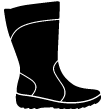During the winter months, most of the country is exposed to adverse weather conditions that increase the risk of a vehicle crash, injury, or illness. Read the information below to learn how to recognize winter hazards, and take appropriate action to protect yourself from potential harm.
Recognize the Hazards
 Environment
Environment
Winter brings many hazardous conditions, including snow, ice, freezing rain, high winds, and frigid temperatures. Sun glare is a distraction that can cause a person to overlook hazards, like potholes or ice patches. Working outside in the elements increases the risk of winter-related illnesses, such as a cold, influenza, or bronchitis.
 Equipment
Equipment
Hitting a pothole hard enough can damage tires and cause a slow leak or possibly a steer tire blowout. An inoperable vehicle heater or malfunctioning window defrosters create driving distractions, while damaged wiper blades can reduce visibility and potentially lead to a crash and possible injury.
 Personal Behaviors
Personal Behaviors
Failing to obey hazard warning signs, distracted walking, and not paying attention to one’s surroundings are examples of unsafe behaviors. Likewise, choosing not to wear proper winter clothing when working outside is achoice that can lead to serious health risks.
Know the Defense
 Be Aware of Surroundings
Be Aware of Surroundings
Being aware of your surroundings is the most important defense against slips, trips, and falls. Avoid distractions while walking, such as talking or texting on a cell phone, conversing with another person, or eating and drinking. Focus your attention on the task at hand and arriving safely at your destination.
 Slow Down
Slow Down
Hurrying is a good way to lose traction or catch your foot on a hazard. In adverse conditions, such as an icy parking lot, a snow-covered roadway, or a slippery entryway, slow down to keep your footing. Also, obey hazard warning signs, like a wet floor sign near exits.
 Wear Proper Shoes and Clothing
Wear Proper Shoes and Clothing
Dressing for the elements can protect you against hypothermia, frostbite, and other winter-related illnesses. Dress in layers and wear a winter coat, hat, and gloves. Wear shoes that have slip-resistant soles for extra traction, or wear cleats over your shoes.
 Plan Ahead
Plan Ahead
Monitor weather forecasts before leaving on a trip. Check for winter weather warnings, road closures, and adverse conditions that may move in unexpectedly. Ensure your vehicle is winterized and the tires have proper tread. Keep an extra blanket, winter clothing, and emergency supplies in the vehicle as a precaution.
Note: These lists are not intended to be all-inclusive.
This material is intended to be a broad overview of the subject matter and is provided for informational purposes only. Joe Morten & Son, Inc. does not provide legal advice to its insureds or other parties, nor does it advise insureds or other parties on employment-related issues, therefore the subject matter is not intended to serve as legal or employment advice for any issue(s) that may arise in the operations of its insureds or other parties. Legal advice should always be sought from legal counsel. Joe Morten & Son, Inc. shall have neither liability nor responsibility to any person or entity with respect to any loss, action, or inaction alleged to be caused directly or indirectly as a result of the information contained herein. Reprinted with permission from Great West Casualty Company.


